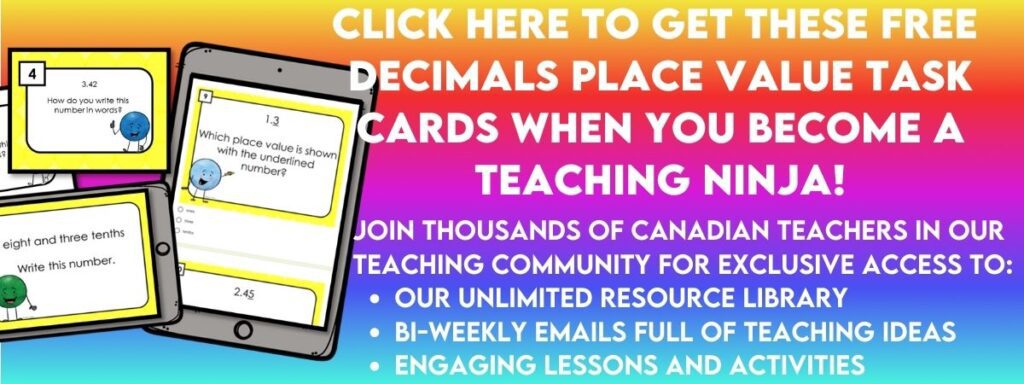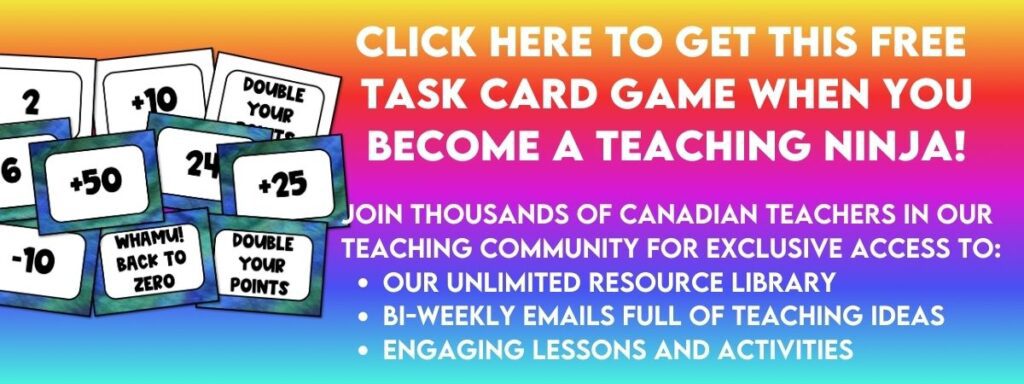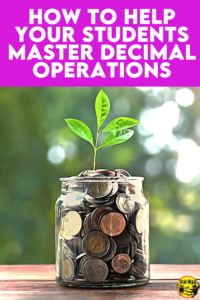
Some students have difficulty working with decimals. Others misunderstand how place value helps when working with decimals operations. And other students struggle with number operations in general. Read on to find out the ways we support the different math learners in our classroom before working with decimal operations.
Before Decimal Operations Teach Decimals Place Value
First, we start with understanding the different place values and symbols that are used when writing decimals. In English Canada, a period is used to represent a decimal point. We explain that in other countries, a decimal can also be represented as a comma. This can be confusing for some students. Make how decimals are represented in number form very clear for your students.
Start With Place Value
In Grade 5, our students are expected to write and say decimals up to the thousandths place value. We start by making an anchor chart naming all the place values of the whole numbers. Then we add a decimal point to the right of the ones column and add three more columns to represent the tenths, hundredths and thousandths places.
We add all this information to our Interactive Math Units.
- Decimals and Fractions Interactive Unit for Grade 4 in our TpT Store ($USD) and our BN Shop ($CAN).
- Decimals and Fractions Interactive Unit for Grade 4/5 in our TpT Store ($USD) and our BN Shop ($CAN). This is designed for combined classrooms so you can teach similar concepts at the same time.
- Decimals and Fractions Interactive Unit for Grade 5 in our TpT Store ($USD) and our BN Shop ($CAN).
- Decimals, Ratios, Fractions and Percent Interactive Unit for Grade 5/6 found in our TpT Store ($USD) and our BN Shop ($CAN). This is designed for combined grade classrooms.
- Decimals, Rations, Fractions and Percent Interactive Unit for Grade 6 in our TpT Store ($USD) and our BN Shop ($CAN).
From here, we practice writing decimals in place value charts or using grids. This helps students identify each place value column which helps students when working with operations.
If you would like to try a set of free task cards that we use with our students to practice representing decimals, we can send them to your inbox. The task cards can be done on paper or online using Google Slides. It can also be found in our Resource Library.
Saying the Names of the Numbers With Decimals
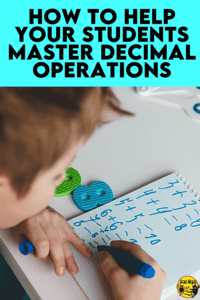
After we show the names of the place values, we teach students how to write and say the decimal names in standard form and in words. It is important to teach students how to say numbers correctly, especially as they begin to work with greater numbers. In Canada, the decimal point is said as the word “and.”
This is where is can get complicated. If students incorrectly learned the names of whole numbers using the word “and,” they may have difficulty saying decimals correctly. Many people say the number 103 as one hundred and three. It should be pronounced one hundred three.
We teach our students to say the whole number before the decimal point, the word “and” to represent the decimal point and then the number followed by the last place value. For example, the number 103.49 would be said as one hundred three and forty-nine hundredths.
Learning to say the decimal names is important, especially when students start relating decimals to fractions, ratios or percent. Understanding decimal place value creates number sense that will help students throughout the rest of their math learning.
We place a Saying Decimals Game with our students to practise saying numbers with decimals. It comes with three different games to different place values. Best of all, it is quick and easy to prepare. Find the Saying Decimals Game in our TpT Store ($USD) or our BN Shop ($CAN).
Once students understand place value and how numbers with decimals are said, they will be able to use this knowledge to begin working on decimal operations.
Before Decimal Operations Teach Number Operations With Whole Numbers
Some students struggle with decimal operations because they struggle with operations in general. Decimals add another layer because the place value can cause errors.
Before moving on to decimals, students should have a strong understanding of operations. If a student struggles with a particular operation, they may need extra support before moving on to decimal operations. Extra support could include help with whole number operations. Tools like anchor charts, checklists, creating a video of the steps or writing out the steps might be useful. Other assistive tools like multiplication charts, manipulatives, or calculators might help, too.
We teach our students error analysis to help them master operations. You might be interested in our blog post, How to Teach Students to Analyze Errors in Math. It comes with an activity to practice analyzing math mistakes.
When Learning Decimals Operations Start With Addition and Subtraction
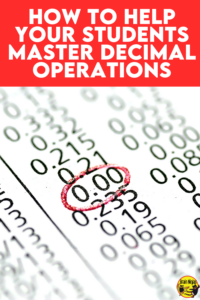
When starting with addition and subtraction of whole numbers, teachers often miss telling students they are lining up the place values. If students understand lining up the ones place, tens place and so on, it makes it easier to transfer this to decimal operations.
While it’s easier to tell students to line up the decimal point, explain that by doing that, students are lining up the place value columns.
We start saying two numbers with decimals out loud. Students have to write down the numbers, which helps them practice the names of the numbers. Then, we have them write the equation down, lining up the place value columns. Before we attempt to solve the question, we have students show us their equation. Sometimes, we don’t even bother finishing the question. We’re just checking they can line everything up. This works great for whiteboards or even writing directly on desks with a whiteboard marker.
Once students can write their equations correctly, it’s a logical step to move on to solving the questions. This is where it will be easy to determine if students struggle with lining everything up or calculating the numbers. That information is helpful when providing students with support.
Ways We Practice Adding and Subtracting Decimals
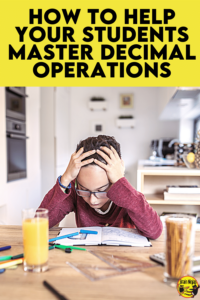
One of the best activities we do with our students is called The Price of Life. It’s a fun activity where students are given an amount of money and then have to go through a series of choices to “buy” items. It is a great way to practice adding and subtraction of numbers with decimals in a real-world context.
Find The Price of Life in our TpT Store ($USD) or our BN Shop ($CAN).
There are lots of ways to differentiate this activity. Last year, the kids loved it so much that they asked to do it a second time with different numbers. If you have strong students who have already mastered adding and subtracting decimals, they can play the role of a banker who checks the answers of other students. They do all the work for you. Otherwise, you can use calculators to help check answers faster. It’s a great activity to get up and moving, but it can be done at seats since the menus are available digitally.
Don’t Underestimate Worksheets
Sometimes, we practice these new skills using worksheets. Our blog post, Math Worksheet Games Your Students Will Love, is full of ideas for how to make worksheets more than a worksheet. If you’re looking for worksheets, try our some of these.
- Addition and Subtraction of Decimals to Hundredths in our TpT Store ($USD) and our BN Shop ($CAN).
- Addition and Subtraction of Decimals to Thousandths in our TpT Store ($USD) and our BN Shop ($CAN).
And We Also Use Task Cards
Sometimes, we use task cards with our students because they love to get up and move around. Our blog post, The Trouble With Task Cards and How to Fix It is full of ways to use task cards. We use our Addition and Subtraction of Decimals Task Cards Grade 4/5. They include equations with hundredths and thousandths. Find them in our TpT Store ($USD) and our BN Shop ($CAN). All of our task cards have three sets of 24 cards, which can be used by printing them on paper or using them online with Google Slides or Google Forms. The Google Forms sets are self-grading.
One of the ways we use task cards is in a game called Whamu! which our students helped create. You can grab a free copy of the game in our Resource Library. We can send a copy directly to your inbox when you sign up to be a teaching ninja with our teaching community.
Then Move to Multiplication and Division of Decimals
When students have a good understanding of how long multiplication and long division work, they are able to translate that into multiplication and division of numbers with decimals. We help our students understand the basic operations as multiplication is repeated addition. Division is repeated subtraction.
Remind students that zeros that come before whole numbers and zeros that are at the end of numbers of decimals are sometimes dropped.
Multiplication of Decimals

We start our multiplication of decimals by showing students on a calculator how the decimal point moves when we multiply by different numbers. One thing we’ve noticed over the years is that students need to be explicitly taught that whole numbers have a decimal point that we don’t write. When we start doing multiplication, we add that decimal point in to show students the place values.
Ask students to multiply 1 by 10 using a calculator. Point out that the result has two digits and after the zero, there is a decimal point. Each time they multiply the number by ten, it will add another zero. This means the decimal point is also moving.
Ask students to multiply 1.5 by 10. What happens to the decimal point? It has moved one place value to the right.
Try it with 1.55 and watch what happens to the decimal point. The decimal point has moved one digit to the right which changes the numbers in each place value column. Explain that the decimal point moves according to the number of digits it is being multiplied (or divided by).
Once students understand this, they can learn the shortcut. Multiply as usual for long multiplication. Count the number of digits behind the decimal point in all the factors being multiplied. Count the same number of place values from the farthest digit to the right and place the decimal point.
Division of Decimals
This is a little more tricky because it requires students to use a long division format when calculating on paper. If a student is using long division with a vinculum, they can place the decimal point from the dividend onto the top of the bar where the quotient will be written. They can divide as normal and the decimal point will land in the quotient in the correct place.
Ways We Practice Multiplication and Division of Decimals
We created Monster Field Trip Activity where students get to use their multiplication and division skills using numbers with decimals. They get to plan a field trip for aliens and it’s so much fun. While it’s not quite a real-world activity, the numbers are all dollar amounts, so it translates to real life.
Find Monster Field Trip in our TpT Store ($USD) or our BN Shop ($CAN).
Since multiplying and dividing numbers with decimals is above the current grade level we teach, we haven’t created worksheets or task cards for them yet.
Do You Teach Math in Canada?
You might find these other blog posts helpful, especially if you teach math in Canada. All of our resources are created using SI Notation, where there are no commas placed between the place values of whole numbers. We also use metric measurements and align our resources first to Alberta and then to the other Canadian provinces and territories.
- Conquer Math With These Proven Multiplication Strategies
- The Truth About New Math
- How to Change Math With Interactive Notebooks
- How to Use Interactive Notebooks to Teach Number Sense
- Mastering the Angles: Innovative Approaches to Teaching Geometry Concepts
- How to Teach Students to Analyze Errors in Math
- How to Add Candy to Your Math Lessons
- Ways to Bring Graphing Activities into Your Classroom Daily
- How to Teach Successful Long Division Strategies
- How to Make Teaching Patterns Painless
- Ways to Teach Classifying Triangles
- How to Teach Rounding Numbers
What other ways do you teach decimals? Leave us a comment to tell us all about it.

